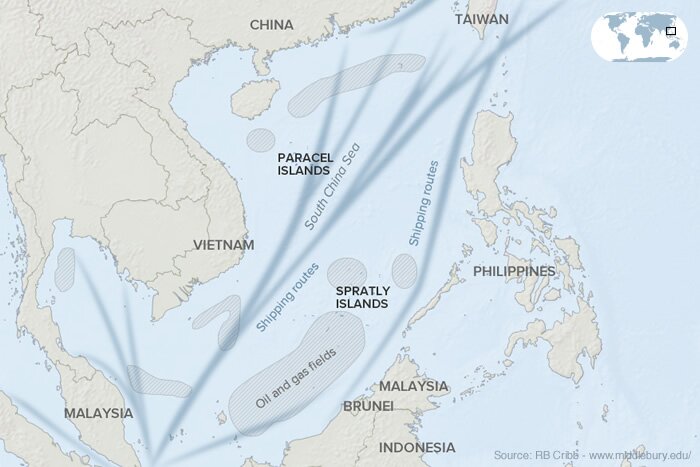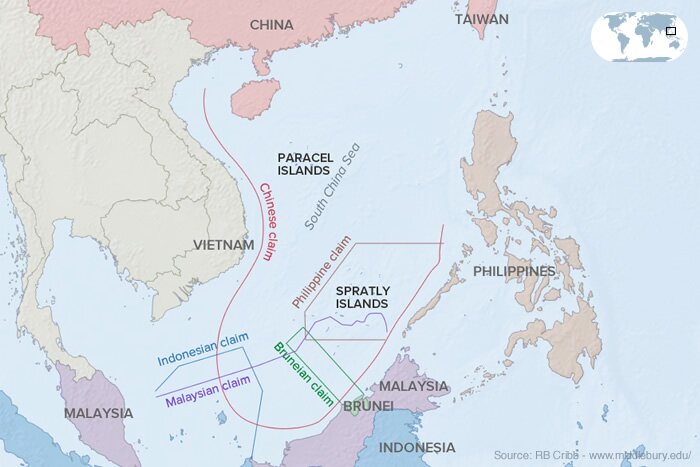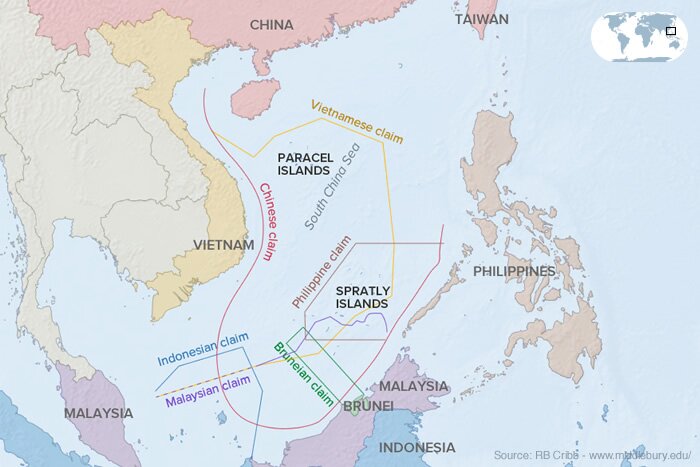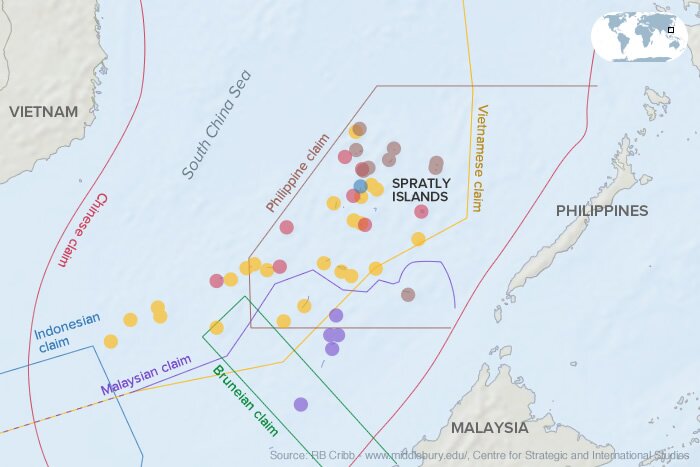Updated February 16, 2016 21:56:50
Foreign Minister Julie Bishop says she will ask the Chinese Government how it intends to use newly reclaimed islands in the South China Sea.
Key points:
- Foreign Minister Julie Bishop en route to China for meeting with Foreign Minister Wang Yi
- Visit comes after a two-day trip to China
- Ms Bishop says she will raise issue of China’s island building in the South China Sea
- Chinese Government spokesman says Philippines arbitration case contravenes international law
Ms Bishop is en route to Beijing for a meeting with China’s Foreign Minister, Wang Yi.
China has carried out construction and reclamation work in the South China Sea and has built a number of islands in international waters.
“Given that President Xi has said that China does not intend to militarise the islands then of course we ask what the construction work on the islands will be used for,” Ms Bishop told reporters in Tokyo, where she met Japanese counterpart Fumio Kishida.
“In the past, Foreign Minister Wang Yi has said they will be public goods and I’m intending to ask how other nations could access these public goods.
“Depending upon the answer he gives, we will look at the situation.”
Ms Bishop added that Australia did not take sides on the completing claims in the waters but was awaiting the outcome of arbitration.
“We recognise the Philippines’ right to seek to resolve the matter through arbitration, but we urge all claimants to settle their disputes peacefully without coercion, without intimidation,” she said.
Asked about the remarks, Chinese Foreign Ministry spokesman Hong Lei said he believed Australia “understands” China’s position on the South China Sea.
Mr Hong repeated that China thought the Philippines arbitration case was a contravention of international law and went against the consensus Beijing and Manila have had on the issue.
“China certainly will not accept this. Australia ought not to selectively avoid this reality,” he told a daily news briefing.
Nearly $7 trillion of trade moves annually through the South China Sea and Brunei, Malaysia, the Philippines, Taiwan and Vietnam have rival claims.
According to the Pentagon, Beijing has reclaimed 1,170 hectares of land in the region since 2013 with its island building projects.
It tested for the first time last month the 3,000-metre runway built on a reclamation on Fiery Cross Reef by landing several civilian airliners from Hainan island.
A Royal Australian Air Force surveillance plane was recorded issuing a warning to China’s Navy “during a freedom of navigation” flight over the South China Sea.
The incident prompted a strongly-worded warning from a state-run newspaper, The Global Times, which said: “Everyone has always been careful, but it would be a shame if one day a plane fell from the sky and it happened to be Australian”.
Vietnam, China, Malaysia have eyes on the prize
Explore the conflicting territorial claims in the South China Sea
| cell-slides | |
|---|---|
 |
Rich in resources and traversed by a quarter of global shipping, the South China Sea is the stage for several territorial disputes that threaten to escalate tensions in the region.
At the heart of these disputes are a series of barren islands in two groups – the Spratly Islands, off the coast of the Philippines, and the Paracel Islands, off the coasts of Vietnam and China. |
 |
Both chains are essentially uninhabitable, but are claimed by no fewer than seven countries, eager to gain control of the vast oil and gas fields below them, as well as some of the region’s best fishing grounds.
Indonesia, Malaysia and Brunei have made claims to part of the Spratlys based on the internationally recognised Exclusive Economic Zone (EEZ), which extends 200 hundred nautical miles from a country’s coastline. |
 |
Based on the EEZ, the Philippines has the strongest claim on the Spratlys and their resources, with its EEZ covering much of the area.
However the lure of resources, and prospect of exerting greater control over shipping in the region, means that greater powers are contesting the Philippines’ claims. |
 |
China has made extensive sovereignty claims on both the Spratlys and the Paracels to the north, based largely on historic claims outlined in a map from the middle part of the 20th Century known as the ‘Nine Dash Map’.
Taiwan also makes claims based on the same map, as it was created by the nationalist Kuomintang government, which fled to Taiwan after the communists seized power in China. |
 |
Vietnam also claims the Spratlys and the Paracels as sovereign territory, extending Vietnam’s EEZ across much of the region and bringing it into direct conflict with China.
There have been deadly protests in Vietnam over China’s decision to build an oil rig off the Paracels. One Chinese worker in Vietnam was killed and a dozen injured in riots targeting Chinese and Taiwanese owned factories, prompting 3,000 Chinese nationals to flee the country. |
 |
EEZ can only be imposed based on boundaries of inhabitable land, and this has prompted all the countries making claims on the region to station personnel, and in some cases build military bases out of the water, to bolster their claim.
Building and protecting these structures has resulted in a series of stand-offs between countries in the region, each with the potential to escalate. China has been leading the charge with these installations, and has deployed vessels to the region to protect their interests. Chinese coast guard vessels have used a water cannon on Vietnamese vessels, as well as blockading an island where the Philippines has deployed military personnel. |
ABC/Reuters
Topics: foreign-affairs, government-and-politics, world-politics, china, australia, asia, pacific
First posted February 16, 2016 17:43:39




